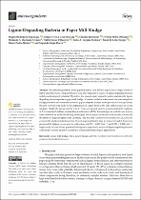Lignin-Degrading Bacteria in Paper Mill Sludge

View/
Author(s)
Rodriguez-Yupanqui, Magda
De La Cruz-Noriega, Magaly
Quiñones, Claudio
Otiniano, Nélida Milly
Quezada-Alvarez, Medardo A.
Rojas-Villacorta, Walter
Vergara-Medina, Gino A.
León-Vargas, Frank R.
Solís-Muñoz, Haniel
Rojas-Flores, Segundo
Date
2023-04-29Subject
Metadata
Show full item recordPublisher
MDPI
Journal
Microorganisms
Abstract
The effluents generated in the paper industry, such as black liquor, have a high content of lignin and other toxic components; however, they represent a source of lignin-degrading bacteria with biotechnological potential. Therefore, the present study aimed to isolate and identify lignin-degrading bacteria species in paper mill sludge. A primary isolation was carried out from samples of sludge present in environments around a paper company located in the province of Ascope (Peru). Bacteria selection was made by the degradation of Lignin Kraft as the only carbon source in a solid medium. Finally, the laccase activity (Um-L−1) of each selected bacteria was determined by oxidation of 2,2′-azinobis-(3-etilbencenotiazolina-6-sulfonate) (ABTS). Bacterial species with laccase activity were identified by molecular biology techniques. Seven species of bacteria with laccase activity and the ability to degrade lignin were identified. The bacteria Agrobacterium tumefasciens (2), Klebsiella grimontii (1), and Beijeinckia fluminensis (1) were reported for first time. K. grimowntii and B. fluminensis presented the highest laccase activity, with values of 0.319 ± 0.005 UmL−1 and 0.329 ± 0.004 UmL−1, respectively. In conclusion, paper mill sludge may represent a source of lignin-degrading bacteria with laccase activity, and they could have potential biotechnological applications.
Type
info:eu-repo/semantics/article
Rights
info:eu-repo/semantics/openAccess
Language
eng
Collections
- Ingeniería Ambiental [83]

